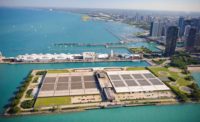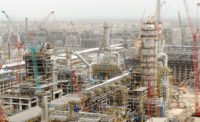Pumped-storage hydroelectricity, a mature technology first developed in the 1890s, is playing an increasingly important role in the current era as wind and solar power advance. "The largest market driver of pumped storage is aggressive renewable-energy goals that are pushing regional power grids to the edge of instability," says Don Erpenbeck, global market sector leader for water power and dams at Stantec. "Developers, power utilities and grid operators are seeing an opportunity to incorporate pumped-storage solutions."
The strongest and most consistent market for pumped-storage hydropower is the refurbishment of the existing 140,000-MW global fleet of plants. Japan has over 27,000 MW, the U.S. has 23,000 MW and Europe has over 25,000 MW of operating (and aging) pumped-storage facilities. Repowering existing plants by installing newer turbines and generators, which produce more electricity with less water, has emerged as a major trend in the past year, according to Erpenbeck. "Companies who own a pumped-storage facility have been studying or have started to implement repowering projects with the goal of increasing the operational flexibility and output of an existing plant," he adds.
New pumped-storage projects are on the rise as well. "The largest growth of new pumped-storage installation will be in China," says Klaus Krueger, manager of product and plant safety and innovation at Voith Hydro Holding GmbH & Co. "China will award up to 29 new pumped-storage plants from now to 2022 and Voith Hydro has already received new orders. The flexibility of the pumped-hydro fleet will be used to avoid curtailment and compensate the intermittency of wind and solar."
"New pumped-storage projects in different parts of the world that currently have little or no pumped storage, like Israel, Australia, Canada, Chile, Argentina and parts of the Middle East, are growing, partly as a result of the increased development of intermittent renewables in these regions that need energy storage to firm up the power and stabilize the grid," says Erpenbeck. "And islanded power grids, like Australia, the U.K., Philippines, Japan and Indonesia, will also see growth driven by energy security needs."
One significant innovation in pumped storage is the introduction of adjustable-speed technology to provide faster response and flexibility in pumping mode. "This adjustable-speed technology is achieved through new types of motor-generator technology as well as the application of full frequency converters added to the back end of traditional-style plants," comments Erpenbeck. "Increased flexibility demand for fast balancing power reserves … will also result in combinations of existing pumped storage with new batteries installed sharing the same switchyard while being able to offer fast governor response mode (primary frequency control) during standstill conditions of pumped hydro," says Krueger.
The largest pumped-storage project currently being developed in the U.S. is the Big Chino Valley project in Arizona, which will have an installed capacity of 2,000 MW. It is being developed by Big Chino Valley Pumped Storage LLC, a subsidiary of ITC Holdings Corp. "ITC anticipates filing its license application with FERC in 2019," says Terry Harvill, president of ITC Grid Development. Construction is expected to commence in 2022 and be completed in 2025. "We're proposing an integrated regional energy solution to meet the energy challenges facing Arizona and other Southwest states. The region is experiencing rapid population growth, increasing energy demands and a changing generation portfolio."
ITC focuses only on transmission, and has no power-generation facilities and no affiliation with market participants. "ITC is generation-neutral as to the type and location of electric energy flowing through our systems," adds Harvill. "This project will provide access to Southwest market hubs, and based on our preliminary discussions with other utilities and potential customers of the project, we see strong interest among power companies in connecting to this project."
The Eagle Mountain Pumped Storage project, located on the site of an abandoned iron mine near the border of Joshua Tree National Park in Southern California, is progressing. Its design calls for using two large abandoned mine pits as reservoirs, separated by 1,400 ft of elevation. It was granted a hydropower license by FERC in 2014. The developer, Eagle Crest Energy Co., has partnered with NextEra Energy, a large energy producer and the owner of several solar farms including Desert Sunlight—a 4,000-acre solar farm located nearby. The 1,300-MW project is expected to cost $2 billion to build.
India is expecting to push forward on a pumped-storage initiative to maximize the use of renewable energy at the lowest possible cost. Officials of the country's Central Electricity Authority expect to set up 10,000 MW of pumped-storage capacity in the coming years, an investment of $12 billion. Solar power projects will be set up near pumped-storage reservoirs, which will stabilize the grid while simultaneously maximizing the use of renewable energy.
The Tamil Nadu Generation and Distribution Corp. is developing the largest pumped-storage project in India, with an installed capacity of 2,000 MW. The first phase will encompass a dam across the Sillahalla River to create the upper reservoir, with an interconnecting tunnel between the dam and the existing Avalanche-Emerald reservoir. The second phase will entail an underground powerhouse with four 500-MW turbines, an access tunnel and power transmission system. The $1.5-billion project will help to harness the full potential of wind power in the region, which otherwise would go untapped during peak wind season.
The 3,600-MW Fengning Pumped Storage Power Station, which is under construction in Hebei Province in China, is expected to be the world's largest pumped-storage plant when it is completed in 2021. It will feature 12 300-MW pump-turbine units. Two of the units are being supplied by Andritz. Gezhouba Group No.2 Engineering Co., a subsidiary of China Energy Engineering Corp., was awarded the contract for the civil construction and metal structure installation. The first generator is expected to be commissioned in 2019, the last in 2021. The construction cost will be $1.87 billion.
The Jixi Pumped Storage Power Station is another very large project under construction, in China's Anhui Province. Four contractors are carrying out the project: China Railway 14th Bureau Group Co., Sinohydro Bureau 5 Co., Sinohydro Bureau 12 Co. and China Gezhouba Group Co. The two dams that will form the reservoirs have been completed, and the first turbine is expected to begin operating in May 2019. All six turbine generators are expected to be operating by August 2020, giving it an installed capacity of 1,800 MW. Construction is expected to cost $1.2 billion.














Post a comment to this article
Report Abusive Comment